Objective 1. Start and Navigate Outlook
Microsoft Office Outlook 2003 has two functions; it is an e-mail program, and it is a personal information manager. Among other things, a personal information manager enables you to store, electronically, information about your friends, family members, coworkers, customers, suppliers, or other individuals with whom you communicate. You can also use a personal information manager to keep track of your daily schedule, tasks you need to complete, and other personal and business-related information. Thus, Outlook's major parts include Mail for e-mail and Calendar, Contacts, and Tasks for personal information management.
Your e-mail and personal information in Outlook is stored in folders, and there are separate folders for each of Outlook's components. For example, the Mail component is stored in a folder called Inbox. Outlook presents information in views, which are ways to look at similar information in different formats and arrangements. Mail, Contacts, Calendar, and Tasks all have different views.
Alert!: Complete This Project in One Working Session
Because Outlook stores information on the hard drive of the computer at which you are working, it is recommended that you schedule enough time to complete this project in one working session, unless you are working on a computer that is used only by you. Allow approximately one to two hours for Project 1A.
Activity 1.1. Starting Outlook
Start Outlook in the same manner as you start other Microsoft Office 2003 programs.
|
1. |
On the Windows taskbar, click the Start button |
||||||||||||||
|
2. |
In the Navigation Pane, click the Mail button Figure 1.2. 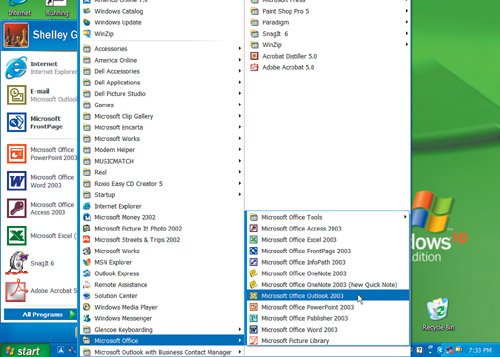
|
||||||||||||||
|
3. |
Look at the opening Outlook screen, and take a moment to study the main parts of the screen as shown in Figure 1.3 and as described in the table in Figure 1.4. Figure 1.3. (This item is displayed on page 66 in the print version) 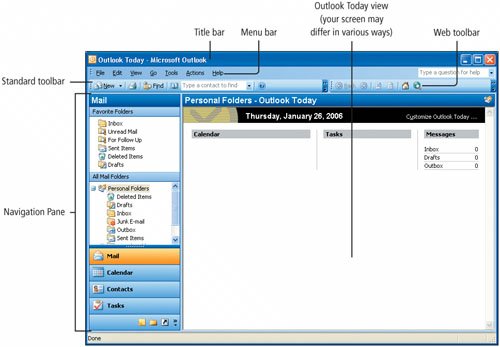
The default view when you open Outlook is Outlook Today, which is a summary view of your schedule, tasks, and e-mail for the current day. Your Outlook screen will differ from the one shown in Figure 1.3. Your program window might display the Inbox instead of Outlook Today. The starting appearance of the screen depends on various settings that were established when Outlook was installed on the computer you are using. |
Activity 1.2. Exploring Outlook Using the Navigation Pane and Folder List
A convenient way to move amongnavigateOutlook's different components is to use the Navigation Pane, which is located on the left side of the Outlook window. The Navigation Pane provides quick access to Outlook's components. Outlook uses folders to organize information, and you can also use the Folder List to move around Outlook. Individual folders store items. An item is an element of information in Outlook, such as a message, a contact name, a task, or an appointment. As you manage the activities of Darron Jacobsen, the Navigation Pane and Folder List will be your tools for moving around Outlook.
|
1. |
Be sure that your Navigation Pane is displayed as shown in Figure 1.3. If necessary, on the menu bar, click View, and then click Navigation Pane to display it. |
|
2. |
In the Navigation Pane, click the Mail button |
|
3. |
In the Navigation Pane, click the Calendar button |
|
4. |
In the Navigation Pane, click the Contacts button |
|
5. |
In the Navigation Pane, click the Tasks button |
|
6. |
In the lower portion of the Navigation Pane, locate the four small buttons that display an icona graphic representation of an object you can select and open. Point to each one to display its ScreenTip, which is a small box that displays the name of a screen element, and then click the Folder List button Figure 1.5. 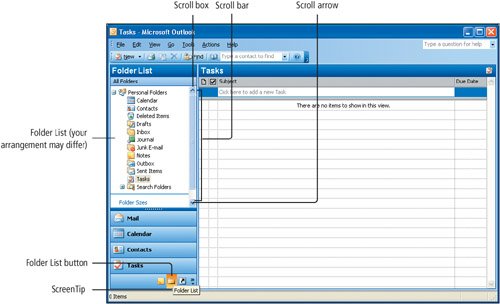
The right portion of the Outlook window continues to display the Tasks folder; the upper portion of the Navigation Pane displays the Folder List. Folders shown in the Navigation Pane may contain more folders than can fit in the All Folders pane. Scrolling is the action of moving a pane or window vertically (up or down) or horizontally (side to side) to bring unseen areas into view. Click the scroll arrow or drag the scroll box to move the pane. |
|
7. |
In the upper portion of the Navigation Pane, under All Folders, locate the first folder, which is also called the root folderthe folder on a drive from which all other folders branch. If your Outlook data is stored in a personal folders file, it will likely be named Personal Folders; if your data is stored on an Exchange Server, it will be named Mailbox. Click either Personal Folders or Mailbox. Alert!: Does Your Screen Differ? Depending on the configuration of Outlook on your system and the size of your screen, the Folder List shown in the Navigation Pane might differ from the one shown in Figure 1.5, which shows a scroll bar that displays on the right side of the All Folders pane. No scroll bar displays if the Folder List fits within the boundaries of the pane. |
|
|
|
|
8. |
If a scroll bar displays on the right side of the Navigation Pane, point to the scroll box, press and hold down the left mouse button, and then drag it downward to display the lower portion of the Folder List. |
|
9. |
In the Folder List, click Inbox to display the Inbox folder. |
|
10. |
In the Folder List, click Notes to display the contents of the Notes folder, as shown in Figure 1.6. Figure 1.6. 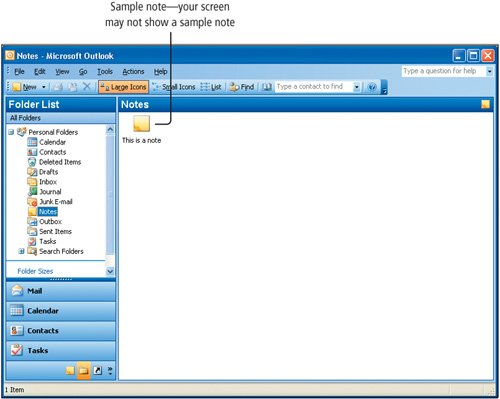
In this manner, you can use the Folder List to display folders that do not have large buttons on the Navigation Pane. Use the Notes component to store bits of information you might use later, such as directions or a question you have for someone. |
|
11. |
In the Navigation Pane, click the Mail button |
More Knowledge: Servers and Exchange Server Accounts
Your e-mail account may be a Microsoft Exchange Server account. Exchange Server is an e-mail based communications server for businesses and organizations. A server is a computer or device on a network that handles shared network resources. Microsoft Exchanger Server functions as a mail server for a business or organization. In an Exchange Server environment, Outlook functions as a client of the server. A client is a program that runs on a personal computer and relies on the server to perform some of its operations. A few Outlook features require an Exchange Server e-mail account. Home users typically do not have Exchange Server accounts. Most home users of Outlook have a POP3 e-mail account with an Internet service provider.
Activity 1.3. Using Menus, Toolbars, and ScreenTips
Outlook commands are organized in menus, which are lists of commands within a category. You perform menu commands by using the menu bar. Toolbars are rows of buttons from which you can perform commands using a single click of the mouse; this is faster than performing the command from the menu. Toolbars are usually located under the menu bar. Recall that a ScreenTip is a small box that contains the name or a descriptive label of a screen element, such as a toolbar button. As you move around Darron Jacobsen's Inbox, the menus, toolbars, and ScreenTips will be available to you.
|
1. |
On the menu bar, click File. Figure 1.7. 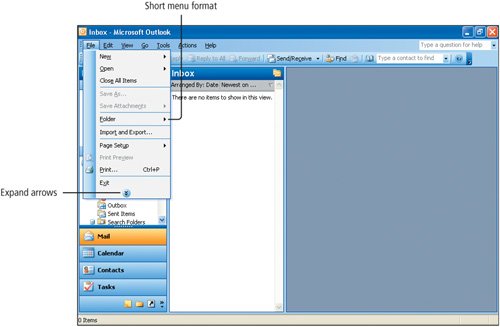
|
|
2. |
On the displayed File menu, point to, but do not click, the New command to display the submenu, as shown in Figure 1.8. Figure 1.8. (This item is displayed on page 72 in the print version) 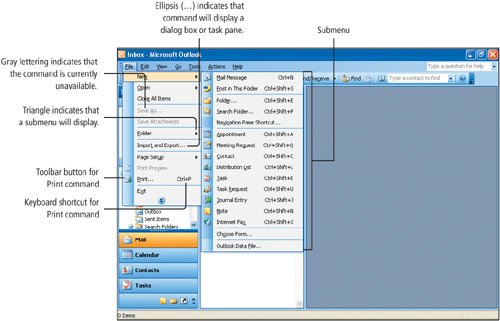
When you point to a command on the menu, the command is shaded and surrounded by a border. Commands that have triangles next to their names will display a submenu, which is another menu of commands. |
|
|
|
|
3. |
Without clicking, move the pointer down the list of commands on the File menu. |
|
4. |
Look to the right of the Print command and notice the keyboard shortcut, Ctrl+P. To the left of this command, notice the image of the toolbar button that represents the Print command on the toolbar, as shown in Figure 1.8. |
|
5. |
Move the pointer away from the menu, and click anywhere in the Outlook window to close the menu without executing any commands. |
|
6. |
On the Standard toolbar, point to the New Mail Message button |
|
|
|
|
7. |
Point to each button on the Standard toolbar, observing the ScreenTip for each button. |
|
[Page 73 (continued)] Objective 2 Read and Respond to E mail |
Windows XP
- Chapter One. Getting Started with Windows XP
- Project 1A. Windows XP
- Objective 1. Get Started with Windows XP
- Objective 2. Resize, Move, and Scroll Windows
- Objective 3. Maximize, Restore, Minimize, and Close a Window
- Objective 4. Create a New Folder
- Objective 5. Copy, Move, Rename, and Delete Files
- Objective 6. Find Files and Folders
- Objective 7. Compress Files
- Summary
- Key Terms
- Concepts Assessments
Outlook 2003
- Chapter One. Getting Started with Outlook 2003
- Getting Started with Microsoft Office Outlook 2003
- Project 1A. Exploring Outlook 2003
- Objective 1. Start and Navigate Outlook
- Objective 2. Read and Respond to E-mail
- Objective 3. Store Contact and Task Information
- Objective 4. Work with the Calendar
- Objective 5. Delete Outlook Information and Close Outlook
- Summary
- Key Terms
- Concepts Assessments
- Skill Assessments
- Performance Assessments
- Mastery Assessments
- Problem Solving
- GO! with Help
Internet Explorer
- Chapter One. Getting Started with Internet Explorer
- Getting Started with Internet Explorer 6.0
- Project 1A. College and Career Information
- Objective 1. Start Internet Explorer and Identify Screen Elements
- Objective 2. Navigate the Internet
- Objective 3. Create and Manage Favorites
- Objective 4. Search the Internet
- Objective 5. Save and Print Web Pages
- Summary
- Key Terms
- Concepts Assessments
- Skill Assessments
- Performance Assessments
- Mastery Assessments
- Problem Solving
Computer Concepts
- Chapter One. Basic Computer Concepts
- Objective 1. Define Computer and Identify the Four Basic Computing Functions
- Objective 2. Identify the Different Types of Computers
- Objective 3. Describe Hardware Devices and Their Uses
- Objective 4. Identify Types of Software and Their Uses
- Objective 5. Describe Networks and Define Network Terms
- Objective 6. Identify Safe Computing Practices
- Summary
- In this Chapter You Learned How to
- Key Terms
- Concepts Assessments
Word 2003
Chapter One. Creating Documents with Microsoft Word 2003
- Chapter One. Creating Documents with Microsoft Word 2003
- Getting Started with Microsoft Office Word 2003
- Project 1A. Thank You Letter
- Objective 1. Create and Save a New Document
- Objective 2. Edit Text
- Objective 3. Select, Delete, and Format Text
- Objective 4. Create Footers and Print Documents
- Project 1B. Party Themes
- Objective 5. Navigate the Word Window
- Objective 6. Add a Graphic to a Document
- Objective 7. Use the Spelling and Grammar Checker
- Objective 8. Preview and Print Documents, Close a Document, and Close Word
- Objective 9. Use the Microsoft Help System
- Summary
- Key Terms
- Concepts Assessments
- Skill Assessments
- Performance Assessments
- Mastery Assessments
- Problem Solving
- You and GO!
- Business Running Case
- GO! with Help
Chapter Two. Formatting and Organizing Text
- Formatting and Organizing Text
- Project 2A. Alaska Trip
- Objective 1. Change Document and Paragraph Layout
- Objective 2. Change and Reorganize Text
- Objective 3. Create and Modify Lists
- Project 2B. Research Paper
- Objective 4. Insert and Format Headers and Footers
- Objective 5. Insert Frequently Used Text
- Objective 6. Insert and Format References
- Summary
- Key Terms
- Concepts Assessments
- Skill Assessments
- Performance Assessments
- Mastery Assessments
- Problem Solving
- You and GO!
- Business Running Case
- GO! with Help
Chapter Three. Using Graphics and Tables
- Using Graphics and Tables
- Project 3A. Job Opportunities
- Objective 1. Insert and Modify Clip Art and Pictures
- Objective 2. Use the Drawing Toolbar
- Project 3B. Park Changes
- Objective 3. Set Tab Stops
- Objective 4. Create a Table
- Objective 5. Format a Table
- Objective 6. Create a Table from Existing Text
- Summary
- Key Terms
- Concepts Assessments
- Skill Assessments
- Performance Assessments
- Mastery Assessments
- Problem Solving
- You and GO!
- Business Running Case
- GO! with Help
Chapter Four. Using Special Document Formats, Columns, and Mail Merge
- Using Special Document Formats, Columns, and Mail Merge
- Project 4A. Garden Newsletter
- Objective 1. Create a Decorative Title
- Objective 2. Create Multicolumn Documents
- Objective 3. Add Special Paragraph Formatting
- Objective 4. Use Special Character Formats
- Project 4B. Water Matters
- Objective 5. Insert Hyperlinks
- Objective 6. Preview and Save a Document as a Web Page
- Project 4C. Recreation Ideas
- Objective 7. Locate Supporting Information
- Objective 8. Find Objects with the Select Browse Object Button
- Project 4D. Mailing Labels
- Objective 9. Create Labels Using the Mail Merge Wizard
- Summary
- Key Terms
- Concepts Assessments
- Skill Assessments
- Performance Assessments
- Mastery Assessments
- Problem Solving
- You and GO!
- Business Running Case
- GO! with Help
Excel 2003
Chapter One. Creating a Worksheet and Charting Data
- Creating a Worksheet and Charting Data
- Project 1A. Tableware
- Objective 1. Start Excel and Navigate a Workbook
- Objective 2. Select Parts of a Worksheet
- Objective 3. Enter and Edit Data in a Worksheet
- Objective 4. Construct a Formula and Use the Sum Function
- Objective 5. Format Data and Cells
- Objective 6. Chart Data
- Objective 7. Annotate a Chart
- Objective 8. Prepare a Worksheet for Printing
- Objective 9. Use the Excel Help System
- Project 1B. Gas Usage
- Objective 10. Open and Save an Existing Workbook
- Objective 11. Navigate and Rename Worksheets
- Objective 12. Enter Dates and Clear Formats
- Objective 13. Use a Summary Sheet
- Objective 14. Format Worksheets in a Workbook
- Summary
- Key Terms
- Concepts Assessments
- Skill Assessments
- Performance Assessments
- Mastery Assessments
- Problem Solving
- You and GO!
- Business Running Case
- GO! with Help
Chapter Two. Designing Effective Worksheets
- Designing Effective Worksheets
- Project 2A. Staff Schedule
- Objective 1. Use AutoFill to Fill a Pattern of Column and Row Titles
- Objective 2. Copy Text Using the Fill Handle
- Objective 3. Use AutoFormat
- Objective 4. View, Scroll, and Print Large Worksheets
- Project 2B. Inventory Value
- Objective 5. Design a Worksheet
- Objective 6. Copy Formulas
- Objective 7. Format Percents, Move Formulas, and Wrap Text
- Objective 8. Make Comparisons Using a Pie Chart
- Objective 9. Print a Chart on a Separate Worksheet
- Project 2C. Population Growth
- Objective 10. Design a Worksheet for What-If Analysis
- Objective 11. Perform What-If Analysis
- Objective 12. Compare Data with a Line Chart
- Summary
- Key Terms
- Concepts Assessments
- Skill Assessments
- Performance Assessments
- Mastery Assessments
- Problem Solving
- You and GO!
- Business Running Case
- GO! with Help
Chapter Three. Using Functions and Data Tables
- Using Functions and Data Tables
- Project 3A. Geography Lecture
- Objective 1. Use SUM, AVERAGE, MIN, and MAX Functions
- Objective 2. Use a Chart to Make Comparisons
- Project 3B. Lab Supervisors
- Objective 3. Use COUNTIF and IF Functions, and Apply Conditional Formatting
- Objective 4. Use a Date Function
- Project 3C. Loan Payment
- Objective 5. Use Financial Functions
- Objective 6. Use Goal Seek
- Objective 7. Create a Data Table
- Summary
- Key Terms
- Concepts Assessments
- Skill Assessments
- Performance Assessments
- Mastery Assessments
- Problem Solving
- You and GO!
- Business Running Case
- GO! with Help
Access 2003
Chapter One. Getting Started with Access Databases and Tables
- Getting Started with Access Databases and Tables
- Project 1A. Academic Departments
- Objective 1. Rename a Database
- Objective 2. Start Access, Open an Existing Database, and View Database Objects
- Project 1B. Fundraising
- Objective 3. Create a New Database
- Objective 4. Create a New Table
- Objective 5. Add Records to a Table
- Objective 6. Modify the Table Design
- Objective 7. Create Table Relationships
- Objective 8. Find and Edit Records in a Table
- Objective 9. Print a Table
- Objective 10. Close and Save a Database
- Objective 11. Use the Access Help System
- Summary
- Key Terms
- Concepts Assessments
- Skill Assessments
- Performance Assessments
- Mastery Assessments
- Problem Solving Assessments
- Problem Solving
- You and GO!
- Business Running Case
- GO! with Help
Chapter Two. Sort, Filter, and Query a Database
- Sort, Filter, and Query a Database
- Project 2A. Club Fundraiser
- Objective 1. Sort Records
- Objective 2. Filter Records
- Objective 3. Create a Select Query
- Objective 4. Open and Edit an Existing Query
- Objective 5. Sort Data in a Query
- Objective 6. Specify Text Criteria in a Query
- Objective 7. Print a Query
- Objective 8. Specify Numeric Criteria in a Query
- Objective 9. Use Compound Criteria
- Objective 10. Create a Query Based on More Than One Table
- Objective 11. Use Wildcards in a Query
- Objective 12. Use Calculated Fields in a Query
- Objective 13. Group Data and Calculate Statistics in a Query
- Summary
- Key Terms
- Concepts Assessments
- Skill Assessments
- Performance Assessments
- Mastery Assessments
- Problem Solving
- You and GO!
- Business Running Case
- GO! with Access Help
Chapter Three. Forms and Reports
- Forms and Reports
- Project 3A. Fundraiser
- Objective 1. Create an AutoForm
- Objective 2. Use a Form to Add and Delete Records
- Objective 3. Create a Form Using the Form Wizard
- Objective 4. Modify a Form
- Objective 5. Create an AutoReport
- Objective 6. Create a Report Using the Report Wizard
- Objective 7. Modify the Design of a Report
- Objective 8. Print a Report and Keep Data Together
- Summary
- Key Terms
- Concepts Assessments
- Skill Assessments
- Performance Assessments
- Mastery Assessments
- Problem Solving
- You and GO!
- Business Running Case
- GO! with Help
Powerpoint 2003
Chapter One. Getting Started with PowerPoint 2003
- Getting Started with PowerPoint 2003
- Project 1A. Expansion
- Objective 1. Start and Exit PowerPoint
- Objective 2. Edit a Presentation Using the Outline/Slides Pane
- Objective 3. Format and Edit a Presentation Using the Slide Pane
- Objective 4. View and Edit a Presentation in Slide Sorter View
- Objective 5. View a Slide Show
- Objective 6. Create Headers and Footers
- Objective 7. Print a Presentation
- Objective 8. Use PowerPoint Help
- Summary
- Key Terms
- Concepts Assessments
- Skill Assessments
- Performance Assessments
- Mastery Assessments
- Problem Solving
- You and GO!
- Business Running Case
- GO! with Help
Chapter Two. Creating a Presentation
- Creating a Presentation
- Project 2A. Teenagers
- Objective 1. Create a Presentation
- Objective 2. Modify Slides
- Project 2B. History
- Objective 3. Create a Presentation Using a Design Template
- Objective 4. Import Text from Word
- Objective 5. Move and Copy Text
- Summary
- Key Terms
- Concepts Assessments
- Skill Assessments
- Performance Assessments
- Mastery Assessments
- Problem Solving
- You and GO!
- Business Running Case
- GO! with Help
Chapter Three. Formatting a Presentation
- Project 3A. Emergency
- Objective 1. Format Slide Text
- Objective 2. Modify Placeholders
- Objective 3. Modify Slide Master Elements
- Objective 4. Insert Clip Art
- Project 3B. Volunteers
- Objective 5. Apply Bullets and Numbering
- Objective 6. Customize a Color Scheme
- Objective 7. Modify the Slide Background
- Objective 8. Apply an Animation Scheme
- Summary
- Key Terms
- Concepts Assessments
- Skill Assessments
- Performance Assessments
- Mastery Assessments
- Problem Solving
- You and GO!
- Business Running Case
- GO! with Help
Integrated Projects
Chapter One. Using Access Data with Other Office Applications
- Chapter One. Using Access Data with Other Office Applications
- Introduction
- Project 1A. Meeting Slides
- Objective 1. Export Access Data to Excel
- Objective 2. Create a Formula in Excel
- Objective 3. Create a Chart in Excel
- Objective 4. Copy Access Data into a Word Document
- Objective 5. Copy Excel Data into a Word Document
- Objective 6. Insert an Excel Chart into a PowerPoint Presentation
Chapter Two. Using Tables in Word and Excel
- Chapter Two. Using Tables in Word and Excel
- Introduction
- Project 2A. Meeting Notes
- Objective 1. Plan a Table in Word
- Objective 2. Enter Data and Format a Table in Word
- Objective 3. Create a Table in Word from Excel Data
- Objective 4. Create Excel Worksheet Data from a Word Table
Chapter Three. Using Excel as a Data Source in a Mail Merge
- Chapter Three. Using Excel as a Data Source in a Mail Merge
- Introduction
- Project 3A. Mailing Labels
- Objective 1. Prepare a Mail Merge Document as Mailing Labels
- Objective 2. Choose an Excel Worksheet as a Data Source
- Objective 3. Produce and Save Merged Mailing Labels
- Objective 4. Open a Saved Main Document for Mail Merge
Chapter Four. Linking Data in Office Documents
- Chapter Four. Linking Data in Office Documents
- Introduction
- Project 4A. Weekly Sales
- Objective 1. Insert and Link in Word an Excel Object
- Objective 2. Format an Object in Word
- Objective 3. Open a Word Document That Includes a Linked Object, and Update Links
Chapter Five. Creating Presentation Content from Office Documents
EAN: 2147483647
Pages: 448
 .
. . In the displayed Start menu, locate the Outlook program, and then click Microsoft Office Outlook 2003. If necessary, on the Outlook title bar, click the Maximize button
. In the displayed Start menu, locate the Outlook program, and then click Microsoft Office Outlook 2003. If necessary, on the Outlook title bar, click the Maximize button  to maximize the Outlook window.
to maximize the Outlook window. to display the Calendar folder.
to display the Calendar folder. to display the Contacts folder.
to display the Contacts folder. to display the Tasks folder.
to display the Tasks folder. to display the Folder List in the upper portion of the Navigation Pane, as shown in Figure 1.5.
to display the Folder List in the upper portion of the Navigation Pane, as shown in Figure 1.5. and then press
and then press  . The result is the same as clicking File on the menu bar and then clicking Print on the File menu.
. The result is the same as clicking File on the menu bar and then clicking Print on the File menu. .
.